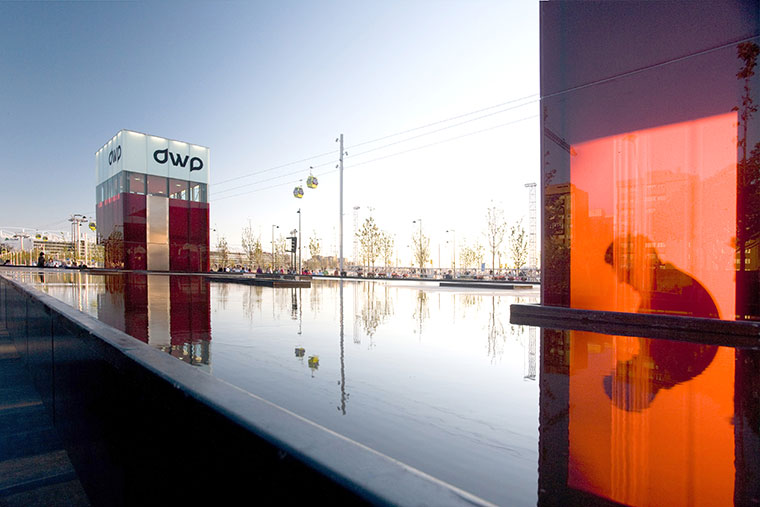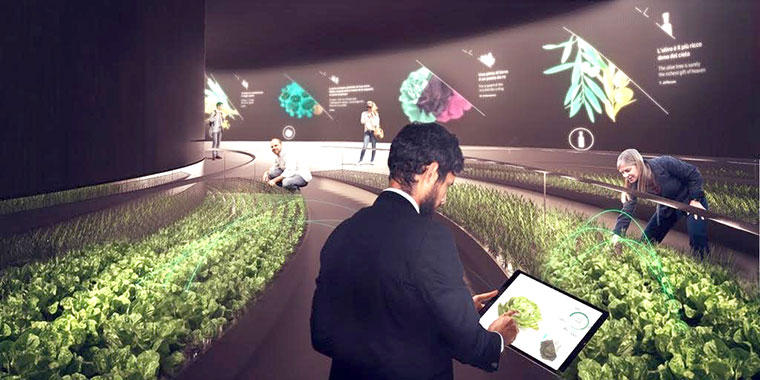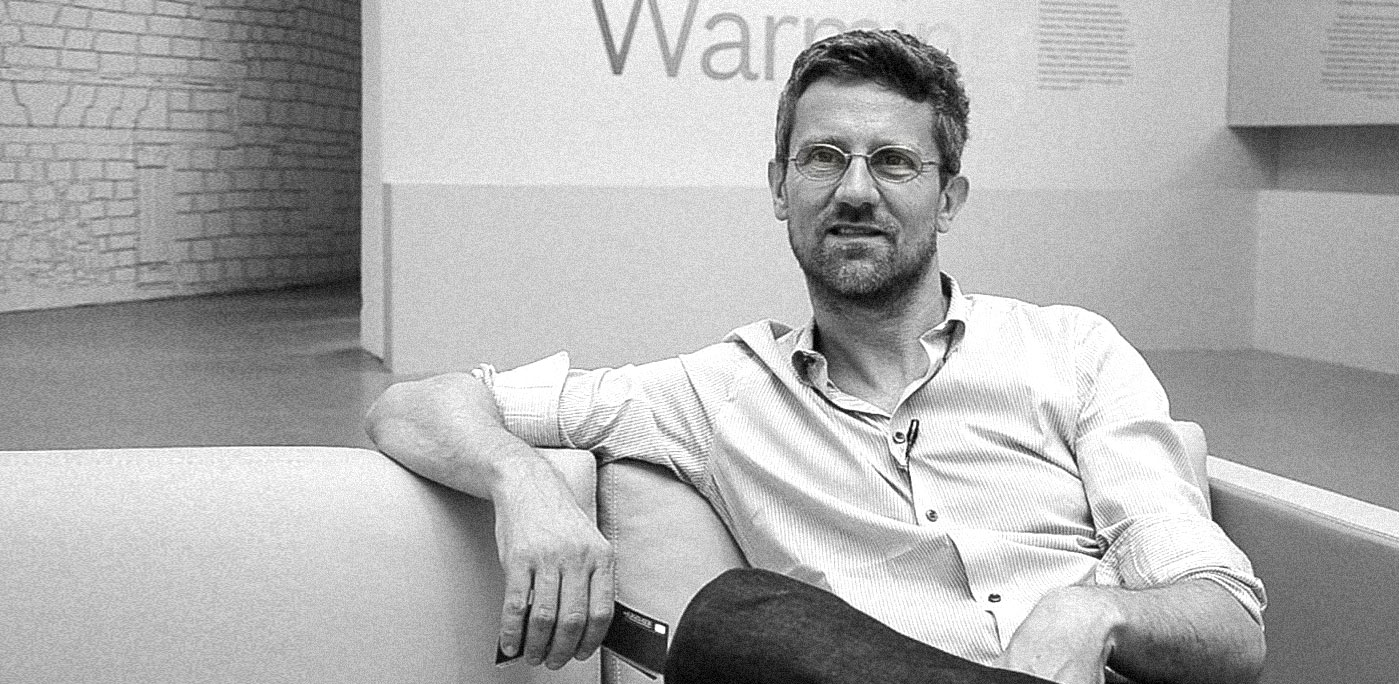The magazine Esquire listed him among the “Best & Brightest,” Forbes among the “Names You Need To Know” and Wired in the list of the “50 people who will change the world,” Fast Company has named him one of the “50 Most Influential Designers In America” and “Thames & Hudson” among the “60 innovators shaping our creative future.”
We are talking about Carlo Ratti, born in Turin in 1971, architect and engineer, professor at the Massachusetts Institute of Technology (MIT) in Boston, where he heads the Senseable City Lab, founder of the design and innovation studio, Carlo Ratti Associati. He graduated from the Politecnico di Torino and the École Nationale des Ponts et Chaussées in Paris, holds a Masters in Philosophy and a PhD in Architecture from the University of Cambridge, in England.

The master plan for the Currie Park waterfront of West Palm Beach, Florida, features a one-of-a-kind floating plaza that utilizes some of the same technologies employed in the construction of underwater vessels
Recently, it made the news that the Carlo Ratti Associati team is involved in the FICO (Fabbrica Italiana Contadina – the Italian Fruit Factory) project for the Eataly brand, which has developed a special interactive pavilion for the opening of Fico Eataly World, a new 80,000 square foot park dedicated to food and food production themes which will open its doors next year in Bologna.
L’Italo-Americano interviewed the Turin architect and professor at MIT.

Carlo Ratti architect and engineer, professor at the Massachusetts Institute of Technology in Boston and founder of the design and innovation studio, Carlo Ratti Associati
Tell us about the Italian Farmhouse project in Bologna. Will it also be implemented in the urban areas of other states, such as the American metropolises?
This kind of urban cultivation may one day be able to really satisfy the food needs of today’s society, but it is an intelligent way to teach those who were born and raised in the city to respect the campaign by utilizing new technologies.
Moving through the space in the pavilion will be like moving in time: walking inside, you will be able to observe the progress of the growth of the plant: at the entrance there will be seeds and sprouts, and then within a few meters, you come to the fully developed plants.
With this project we highlight three concepts: past, innovation and production. There will be an area investigating future cultivation systems, a collaborative agriculture pavilion and a large circular hydroponic garden where visitors can choose and plant their seeds and watch and study the experience of growing and the development of the plant over time, even from home, through an app.

The master plan for the Currie Park waterfront of West Palm Beach, Florida, features a one-of-a-kind floating plaza that utilizes some of the same technologies employed in the construction of underwater vessels
Can you explain the concept of Senseable City applied to American metropolises?
The concept of Senseable City is simply the manifestation of a wider technological trend: the Internet is entering the space in which we live and becoming an “Internet of things,” embracing any aspect of our existence, from waste management to transportation, from water distribution to city planning to involve citizens. In our projects we try to explore how the internet of things is creating a new approach to studying the constructed environment. Our work seeks to allow a new relationship between people, technology and the city – by developing both research and applications, and making sure citizens have the tools to make choices that will better everyone’s lifestyle.
This attention to the human side is certainly the common denominator in most of our projects – whether carried out by Carlo Ratti Associati or the MIT Senseable City Lab.

Carlo Ratti Associati team is involved in the FICO (Fabbrica Italiana Contadina – the Italian Fruit Factory) project for the Eataly brand, which has developed a special interactive pavilion for the opening of Fico Eataly World, a new 80,000 square foot park dedicated to food and food production themes which will open its doors next year in Bologna
With that said, what will this mean for American metropolises? This is my hope: an improvement in the quality of life and a more efficient management of the res publica. However, there will be no foreseeable future, nor can it be reduced to a single answer: I am convinced that the best approach to managing a city is the participatory one – this means that citizens will be inventing the future city they want to live in.
As you see it, with respect to the technological development of urban areas, an operation such as the creation of the high line in NYC and the new low line, which reuses abandoned spaces to install green spaces, would it possibly also be exploitable for cultivation at ground 0? I am referring to the eHabitat project with the application of new technologies as well as to the world of food and sustainability.
I am very interested in the theme of the relationship between city and nature, and I believe that thanks to some new cultivation technologies – from hydroponics to vertical farming – it is possible to develop very interesting experiments. Beyond the New York case, Singapore is studying vertical farms to cover the facades of its skyscrapers, and in many metropolises there are abundant examples of gardens on the roofs of homes or in the unused corners of the streets.
Will urban agriculture alone satisfy the food demand of millions of citizens? Probably not, even for space and energy reasons (the amount of sunlight that hits an urban area is usually less than what is required for a field). However, it can play a key role in helping us strengthen our bond with nature – and with the surprise of life that is renewed following the seasons.
The hope is that, in the age of tomorrow, new technologies can allow an unprecedented integration of nature and culture. I have always been fascinated by the words of Elysée Reclus, the French anarchist geographer who at the end of the nineteenth century wrote: “Man should have the doubled advantage of access to the pleasures of the city […], the opportunities offered for the study and practice of art, and at the same time should be able to enjoy the freedom that lies in the freedom of nature, and which is explained in the field of its vast horizon.”
Is the United States, in your view, receptive to this kind of innovative injection?
The United States is a universe – I’m not sure, for example, that President Trump’s environmental and therefore urban policies are particularly open. At the same time, I’m comfortable with what I see every day in Cambridge, Massachusetts, a city able to experience the boundary between human and urban sustainability like few others in the world.
La rivista Esquire lo ha inserito tra i “Best & Brightest”, Forbes tra i “Names You Need to Know” e Wired nella lista delle “50 persone che cambieranno il mondo”, Fast Company lo ha nominato tra i “50 designer più influenti in America” e Thames & Hudson tra i “60 innovators shaping our creative future”.
Parliamo di Carlo Ratti, classe 1971, nato a Torino, architetto e ingegnere, docente al Massachusetts Institute of Technology (MIT) di Boston, dove dirige il Senseable City Lab, fondatore dello studio di design e innovazione Carlo Ratti Associati. Laureato al Politecnico di Torino e all’École Nationale des Ponts et Chaussées a Parigi, ha conseguito un Master in Philosophy e un PhD in Architettura all’Università di Cambridge, in Inghilterra.
Da poco è stata resa nota la notizia che il team Carlo Ratti Associati, è coinvolto nel progetto FICO (Fabbrica Italiana Contadina) per il marchio Eataly che ha messo a punto uno speciale padiglione interattivo in vista dell’apertura del Fico Eataly World, un nuovo parco di 80mila metri quadrati dedicato ai temi dell’alimentazione e della produzione di cibo che aprirà i battenti il prossimo anno a Bologna.
L’Italo-Americano ha intervistato l’architetto torinese e docente del MIT.
Ci parli del progetto della Fabbrica Italiana Contadina di Bologna. Sarà anche attuabile anche negli spazi urbani di altri Stati, come le metropoli americane?
Questo tipo di coltivazioni urbane potrà arrivare un giorno a soddisfare realmente il bisogno di cibo della società di oggi, ma è un modo intelligente per educare chi è nato e cresciuto in città al rispetto della campagna sfruttando le nuove tecnologie.
Muoversi attraverso lo spazio del padiglione sarà come muoversi nel tempo: camminado al suo interno sarà possibile osservare i progressi della crescita della pianta: all’ingresso ci saranno semi e germogli, per poi arrivare a piante pienamente sviluppate nell’arco di pochi metri.
Nel progetto sottolineiamo tre concetti: passato, innovazione e produzione. Ci sarà un’area che indaga sui sistemi di coltivazione futura, un padiglione dell’agricoltura collaborativa e un grande giardino idroponico circolare, dove i visitatori potranno scegliere e piantare i propri semi e vivere e studiare l’esperienza della crescita e lo sviluppo della pianta nel tempo, anche da casa, tramite una app.
Ci può spiegare il concetto di Senseable city applicato alle metropoli americane?
Il concetto di Senseable City è semplicemente la manifestazione di trend tecnologico più ampio: Internet sta entrando nello spazio nel quale viviamo e sta diventando Internet delle cose, abbracciando qualsiasi aspetto della nostra esistenza, dalla gestione dei rifiuti alla mobilità, alla distribuzione dell’acqua, alla pianificazione delle città al coinvolgimento dei cittadini. Nei nostri progetti cerchiamo di esplorare come l’internet delle cose stia dando vita ad un nuovo approccio per studiare l’ambiente costruito. Il nostro intervento cerca di permettere un nuovo rapporto tra persone, tecnologie e la città – sviluppando sia ricerca sia applicazioni, e facendo sì che i cittadini abbiano gli strumenti per fare delle scelte che risultino in uno stile di vita migliore per tutti.
Questa attenzione al lato umano è sicuramente il denominatore comune della maggior parte dei nostri progetti – sia quelli portati avanti da Carlo Ratti Associati o al MIT Senseable City Lab.
Detto ciò, cosa comporterà questo per le metropoli americane? Questo il mio auspicio: un miglioramento della qualità della vita e una gestione più efficiente della res publica. Tuttavia non ci sarà un futuro prevedibile né riducibile ad una singola risposta: sono convinto che l’approccio migliore per la gestione di una città sia quello partecipativo – questo significa che saranno i cittadini a inventare la città futura in cui vorranno vivere.
Come vede, rispetto allo sviluppo tecnologico delle aree urbane un’operazione come la creazione della high line a NYC e della nuova low line, che riutilizza spazi abbandonati per installare spazi verdi, magari sfruttabili anche per la coltivazione a km 0? Mi riferisco al progetto eHabitat con applicazione delle nuove tecnologie anche al mondo del cibo e della sostenibilità.
Mi interessa molto la tematica del rapporto tra città e natura, e credo che grazie ad alcune nuove tecnologie di coltivazione – dall’idroponica al vertical farming – sia possibile mettere a punto sperimentazioni molto interessanti. Al di là del caso di New York, Singapore sta studiando fattorie verticali con cui coprire le facciate dei propri grattacieli, e in molte metropoli si trovano esempi abbondanti di orti sui tetti delle case o negli angoli prima inutilizzati delle strade.
Potrà l’agricoltura urbana da sola soddisfare la domanda alimentare di milioni di cittadini? Probabilmente no, anche solo per ragioni spaziali ed energetiche (la quantità di luce solare che colpisce un’area urbana è di solito inferiore a quella necessaria per un campo). Tuttavia potrà giocare un ruolo chiave nell’aiutarci a rafforzare il nostro legame con la natura – e con la sorpresa della vita che si rinnova seguendo le stagioni.
La speranza è che le nuove tecnologie possano domani permettere un’inedita integrazione tra natura e cultura. Mi hanno sempre affascinato le parole di Elysée Reclus, il geografo anarchico francese che alla fine dell’Ottocento scriveva: “L’uomo dovrebbe avere il doppio vantaggio di un accesso ai piaceri della città […], alle opportunità che offre allo studio e alla pratica dell’arte, e, allo stesso tempo, dovrebbe poter godere la libertà che si trova nella libertà della natura, e che si spiega nel campo del suo vasto orizzonte.”
Gli Stati Uniti, a suo avviso, sono ricettivi a questo tipo di iniezioni innovative?
Gli Stati Uniti sono un universo – non sono sicuro, ad esempio, che le politiche ambientali e quindi anche urbane del presidente Trump siano particolarmente aperte. Al tempo stesso mi conforta quello che vedo ogni giorno a Cambridge, Massachusetts, città capace di sperimentare al confine tra sostenibilità umana e urbana come poche altre al mondo.
































